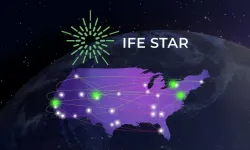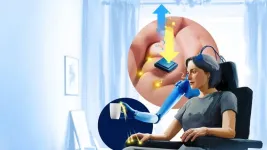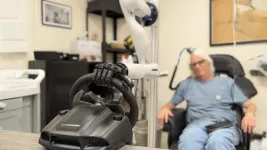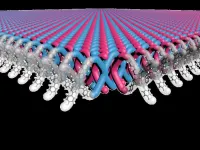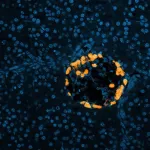(Press-News.org) The University of Rochester’s Laboratory for Laser Energetics (LLE) has been awarded a $2.25 million grant over three years from the US Department of Energy’s Office of Fusion Energy Sciences. This funding establishes the Inertial Fusion Energy Science and Technology Accelerated Research (IFE-STAR) ecosystem that brings together academia, national laboratories, and the private sector to develop a clean, safe, and virtually limitless energy source, built on US leadership in inertial fusion.
Inertial fusion energy (IFE) is a cutting-edge technology that mimics the sun’s energy production process by fusing atomic nuclei under extreme conditions. Unlike traditional nuclear energy, IFE offers the promise of base-load energy with minimal radioactive waste, and a nearly limitless fuel supply. To more rapidly advance the nation’s path to fusion energy, the IFE-STAR ecosystem will advance fusion science and technology by building a national network of coordination and collaboration, while developing the scientists and engineers to grow and sustain the inertial fusion energy community.
The IFE-STAR program brings together three leading research institutions, each spearheading a unique hub to advance IFE science and technology:
LLE’s IFE Consortium on Laser-Plasma Interaction Research (IFE-COLoR) hub
Lawrence Livermore National Laboratory’s Science and Technology Accelerated Research (STARFIRE) hub
Colorado State University’s Research in Inertial and Sustainable Energy (RISE) hub
These hubs will leverage their expertise and resources to address critical challenges in IFE development, from target physics to driver technologies. In addition to the individual hubs, the overall ecosystem is envisioned to be inclusive of all current and future viable IFE concepts.
IFE-STAR aims to address critical objectives in IFE development, including:
Advancing IFE science and technology
Enhancing coordination and collaboration among researchers
Developing a diverse and skilled workforce
Creating an online platform for information sharing and resource allocation
“By uniting world-leading researchers and institutions, we aim to accelerate the development of a new energy industry that could revolutionize our approach to clean, sustainable power,” says Christopher Deeney, the director of LLE.
Shaping the future of fusion energy research
This year the initiative will launch an annual conference and a summer undergraduate research experience for developing a fusion-ready workforce.
The IFE-STAR program will host its inaugural conference April 7 to 11, 2025, in Breckenridge, Colorado. This event brings together leading researchers from around the world to discuss the latest advancements and challenges in IFE development.
Another key component of the IFE-STAR initiative is its commitment to developing future talent in the field of fusion energy. To that end, the program is launching a summer research opportunity—IFE-STAR Summer Undergraduate Research Experience (SURE)—offering undergraduate students across the US hands-on experience working alongside leading IFE scientists and engineers across more than 20 institutions, including private industry partners.
“The IFE-STAR Ecosystem initiative’s emphasis on student involvement and cross-institutional collaboration is crucial in developing a fusion-ready workforce,” says Jean Paul Allain, the associate director of science for DOE’s Fusion Energy Sciences (FES) program. “By fostering collaboration and nurturing talent from all sectors, we ensure that the transition to fusion energy becomes not only a scientific triumph but also a societal transformation.”
About the Laboratory for Laser Energetics
Founded in 1970 at the University of Rochester, the Laboratory for Laser Energetics (LLE) houses the world’s two largest laser systems at any academic institution. Renowned for its pioneering research in inertial confinement fusion, plasma physics, high-energy-density physics, and advanced laser technologies, LLE has made transformative contributions to these fields, including groundbreaking work that contributed to the 2018 Nobel Prize in Physics. Led by a team of award-winning scientists, engineers, researchers, and technicians, LLE not only drives cutting-edge scientific discovery but also plays a vital role in educating and training the next generation of scientists, engineers, and technicians.
END
Laboratory for Laser Energetics at the University of Rochester launches IFE-STAR ecosystem and workforce development initiatives
Inaugural annual conference and summer student programs foster partnerships among academia, national labs, and private sector
2025-01-16
ELSE PRESS RELEASES FROM THIS DATE:
Most advanced artificial touch for brain-controlled bionic hand
2025-01-16
For the first time ever, a complex sense of touch for individuals living with spinal cord injuries is a step closer to reality. A new study published in Science, paves the way for complex touch sensation through brain stimulation, whilst using an extracorporeal bionic limb, that is attached to a chair or wheelchair.
The researchers, who are all part of the US-based Cortical Bionics Research Group, have discovered a unique method for encoding natural touch sensations of the hand via specific microstimulation patterns in implantable electrodes in the brain. This allows individuals with spinal cord injuries ...
Compounding drought and climate effects disrupt soil water dynamics in grasslands
2025-01-16
A novel field experiment in Austria reveals that compounding climate conditions – namely drought, warming, and elevated atmospheric carbon dioxide (CO2 ) – could fundamentally reshape how water moves through soils in temperate grasslands. The findings provide new insights into post-drought soil water flow, in particular. Soil water, though a minuscule fraction of Earth's total water resources, plays a critical role in sustaining terrestrial life on Earth by regulating biogeochemical cycles, surface energy balance, and plant productivity. Soils also govern ...
Multiyear “megadroughts” becoming longer and more severe under climate change
2025-01-16
Severe droughts are becoming hotter, longer, and increasingly devastating to ecosystems as climate change accelerates, according to a new study, which reports that temperate grasslands, including in parts of the United States, are facing the worst effects. The findings provide a global quantitative understanding of multiyear droughts (MYDs) – prolonged events lasting years or decades – and offer a benchmark for understanding their global trends and impacts. As droughts become more frequent ...
Australopithecines at South African cave site were not eating substantial amounts of meat
2025-01-16
Seven Australopithecus specimens uncovered at the Sterkfontein fossil site in South Africa were herbivorous hominins who did not eat substantial amounts of meat, according to a new study by Tina Lüdecke and colleagues. Lüdecke et al. analyzed organic nitrogen and carbonate carbon isotopes extracted from tooth enamel in the fossil specimens to determine the hominin diets. Some researchers have hypothesized that the incorporation of animal-based foods in early hominin diets led to increased brain size, smaller gut size ...
An AI model developed to design proteins simulates 500 million years of protein evolution in developing new fluorescent protein
2025-01-16
Guided by a multimodal generative language model called ESM3, Thomas Hayes and colleagues generated and synthesized a previously unknown bright fluorescent protein, with a genetic sequence so different from known fluorescent proteins that the researchers say its creation is equivalent to ESM3 simulating 500 million years of biological evolution. The model could provide a new way to “search” the space of protein possibilities with an eye to better understanding how naturally evolved proteins work, as well as developing novel proteins for uses in medicine, environmental remediation, and a host of other applications. ESM3 can reason over protein ...
Fine-tuned brain-computer interface makes prosthetic limbs feel more real
2025-01-16
You can probably complete an amazing number of tasks with your hands without looking at them. But if you put on gloves that muffle your sense of touch, many of those simple tasks become frustrating. Take away proprioception — your ability to sense your body’s relative position and movement — and you might even end up breaking an object or injuring yourself.
“Most people don’t realize how often they rely on touch instead of vision — typing, walking, picking up a flimsy cup of water,” said Charles Greenspon, PhD, a neuroscientist at the University of Chicago. “If you can’t feel, you have ...
New chainmail-like material could be the future of armor
2025-01-16
EVANSTON, Il. --- In a remarkable feat of chemistry, a Northwestern University-led research team has developed the first two-dimensional (2D) mechanically interlocked material.
Resembling the interlocking links in chainmail, the nanoscale material exhibits exceptional flexibility and strength. With further work, it holds promise for use in high-performance, light-weight body armor and other uses that demand lightweight, flexible and tough materials.
Publishing on Friday (Jan. 17) in the journal ...
The megadroughts are upon us
2025-01-16
Increasingly common since 1980, persistent multi-year droughts will continue to advance with the warming climate, warns a study from the Swiss Federal Institute for Forest, Snow, and Landscape Research (WSL), with Professor Francesca Pellicciotti from the Institute of Science and Technology Austria (ISTA) participating. This publicly available forty-year global quantitative inventory, now published in Science, seeks to inform policy regarding the environmental impact of human-induced climate change. It also detected previously ‘overlooked’ events.
Fifteen years of a persistent, devastating megadrought—the longest lasting in a thousand years—have nearly dried out ...
Eavesdropping on organs: Immune system controls blood sugar levels
2025-01-16
When we think about the immune system, we usually associate it with fighting infections. However, a study published in Science by the Champalimaud Foundation reveals a surprising new role. During periods of low energy—such as intermittent fasting or exercise—immune cells step in to regulate blood sugar levels, acting as the “postman” in a previously unknown three-way conversation between the nervous, immune and hormonal systems. These findings open up new approaches for managing conditions like diabetes, obesity, and cancer.
Rethinking the Immune ...
Quantum engineers ‘squeeze’ laser frequency combs to make more sensitive gas sensors
2025-01-16
The trick to creating a better quantum sensor? Just give it a little squeeze.
For the first time ever, scientists have used a technique called “quantum squeezing” to improve the gas sensing performance of devices known as optical frequency comb lasers. These ultra-precise sensors are like fingerprint scanners for molecules of gas. Scientists have used them to spot methane leaks in the air above oil and gas operations and signs of COVID-19 infections in breath samples from humans.
Now, in a series of lab experiments, researchers have laid out a path for making those kinds of measurements even more sensitive and faster—doubling the speed of ...
LAST 30 PRESS RELEASES:
Hospitals acquired by real estate investment trusts associated with greater risk of bankruptcy, closure
City of Hope scientists study rare disorder to uncover mechanism and hormone regulation underlying fatty liver disease and sweet aversion
Your genes may influence gut microbiome of others, rat study shows
‘Personality test’ shows how AI chatbots mimic human traits – and how they can be manipulated
Global food systems driving twin crises of obesity and global heating
Osaka Medical and Pharmaceutical University researchers capture real-time molecular movies of enzyme catalysis
Could your genes influence the gut microbiome of others?
Clues to Alzheimer’s disease may be hiding in our ‘junk’ DNA
Study reveals that the body uses different sensors to detect cold in the skin and in internal organs
iPS cells from dish to freezer and back
Deep neural networks enable accurate pricing of American options under stochastic volatility
Collective risk resonance in Chinese stock sectors uncovered through higher-order network analysis
Does CPU impact systemic risk contributions of Chinese sectors? Evidence from mixed frequency methods with asymmetric tail long memory
General intelligence framework to predict virus adaptation based on a genome language model
Antibiotic resistance is ancient, ecological, and deeply connected to human activity, new review shows
Vapes, pouches, heated tobacco, shisha, cigarettes: nicotine in all forms is toxic to the heart and blood vessels
From powder to planet: University of Modena engineers forge a low-carbon future for advanced metal manufacturing
Super strain-resistant superconductors
Pre-school health programme does not improve children’s diet or physical activity, prompting call for policy changes, study finds
Autumn clock change linked to reduction in certain health conditions
AI images of doctors can exaggerate and reinforce existing stereotypes
Where medicine meets melody – how lullabies help babies and parents in intensive care
We may never be able to tell if AI becomes conscious, argues philosopher
AI video translation shows promise but humans still hold the edge
Deep ocean earthquakes drive Southern Ocean’s massive phytoplankton blooms, study finds
Without campus leftovers to pick through, the beaks of this bird changed shape during the pandemic
High-dose antibiotic does not reduce mortality in tuberculous meningitis
How many insects fly in the sky above the USA?
Could cheese protect your brain health?
Who faces more difficulty recovering from stroke?
[Press-News.org] Laboratory for Laser Energetics at the University of Rochester launches IFE-STAR ecosystem and workforce development initiativesInaugural annual conference and summer student programs foster partnerships among academia, national labs, and private sector
